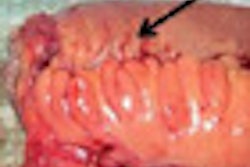Individuals with several diminutive colon polyps on virtual colonoscopy studies are far more likely than other screening subjects to also have a larger colorectal lesion, say researchers from the University of Munich in Germany.
Because polyps 5 mm and smaller are unlikely to harbor advanced histology -- and because VC has an uneven track record for finding them -- diminutive polyps found at virtual colonoscopy (also known as CT colonography or CTC) aren't reported using either C-RADS or European Society of Gastrointestinal and Abdominal Radiology (ESGAR) criteria.
Telling patients they have a diminutive lesion isn't a winning strategy, either, because it can cause unnecessary concern, said Dr. Anno Graser in a presentation at the 2010 European Congress of Radiology (ECR).
"We all see small polyps at CTC; we see them frequently, and we know we're able to detect them," Graser said. "We've been thinking about what their actual frequency is and whether they have any implications for colorectal cancer screening."
Data from the U.S. National Polyp Study suggest that they occur frequently, but there is insufficient data on their meaning and natural history. A recent study of approximately 1,200 asymptomatic adults found diminutive lesions in about 10% of the cohort, with advanced histology in about 1.7% of these, Graser said.
Graser's group wanted to analyze CTC's diagnostic accuracy in polyps 5 mm and smaller, and also assess whether the number of diminutive lesions detected at CTC is a predictor of large adenomas.
The researchers examined a total of 332 asymptomatic individuals (190 men, 142 women; age 59.2 ± 7.6 years). Segmentally unblended optical colonoscopy served as the reference standard in all patients. All polyps were resected at colonoscopy and the histology was graded as advanced, hyperplastic, or other, Graser said.
Graser and colleagues calculated the percentage probability of detecting an adenoma larger than 5 mm in patients with fewer than three versus three or more diminutive polyps, testing for statistical difference using a Wilcoxon signed-rank test.
Before scanning, all patients underwent a cathartic bowel cleansing preparation with 4 L polyethylene glycol, followed by 50 mL of iodinated oral contrast the morning of the VC exam, then same-day colonoscopy. All images were acquired on a 64-detector-row scanner using 0.6-mm collimation and read by radiologists who were experts in VC interpretation using a primary 3D reading method, Graser said.
Virtual colonoscopy's sensitivity for polyps larger than 5 mm was 90.7% (88/97), 44.4% (126/284) for diminutive nonadenomatous lesions, and 59.1% (88/149) for diminutive adenomas, Graser reported. Most tiny lesions, even if not reported initially at VC, could be seen retrospectively, he said.
Radiologists were specifically instructed to report diminutive lesions for this study.
Of the total 530 polyps in the cohort, 433 were 5 mm and smaller compared to just 97 lesions 6 mm and larger, he said. In all, 59% of the diminutive lesions were adenomatous.
"If you look at the sensitivity of CTC for diminutive lesions, in patients where a 6 mm or larger polyp is present, it's 75.5%," he said. "In patients where the large lesions (> 6 mm) are absent, it's only 61%. That means if a larger lesion is present, keep your eyes open for smaller lesions."
In patients with fewer than three diminutive polyps, the probability of an adenoma larger than 5 mm was less than 12.5%; in patients with three or more diminutive polyps, it was 35.9% (p < 0.0001), meaning that the probability of an adenoma larger than 6 mm increases with the number of diminutive polyps, Graser said.
"Detection rates for diminutive polyps are higher in patients who also have larger polyps," he concluded. "Sensitivity is higher for diminutive adenomas than nonadenomas -- probably due to the fact that adenomas are simply less deformable when we inflate the colon."
Finally, when three or more diminutive lesions are found, there's a 37% chance that a larger lesion is present.
"So if you see some of these small lesions, keep your eyes open for larger lesions," Graser said.
By Eric Barnes
AuntMinnie.com staff writer
April 16, 2010
Related Reading
VC obviates need for colonoscopy even in symptomatic patients, February 24, 2010
VC screening effective in Medicare-age screening cohort, January 27, 2010
Surveillance polyps show little growth at follow-up, November 30, 2009
New ACR guidelines overhaul VC practice, training standards, November 27, 2009
Meta-analysis reveals paucity of advanced neoplasia in small polyps, November 2, 2009
Copyright © 2010 AuntMinnie.com


















